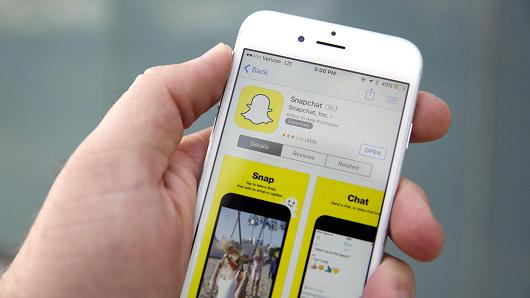
The newest generation of technology darlings has signaled that it is about to come of age: Snapchat, the messaging service beloved by teenagers, is preparing to step out into the public markets.
The company — born only five years ago — may end up ushering in a wave of huge tech initial public offerings at a time when Wall Street has seen few such big deals.
Snapchat’s parent, recently renamed Snap Inc., has hired the investment banks Morgan Stanley and Goldman Sachs, essentially firing a starting gun for a potential stock sale as soon as the first quarter of next year, people briefed on the matter said on Wednesday.
More from NY Times:
Snapchat proves its staying power
Snapchat used to spook advertisers…but not anymore
Twitter’s troubles and Snap’s appeal
Should Snap follow through on its plans, it would be the most prominent debut by the latest batch of “unicorns” — those private companies valued at more than $1 billion. Its class also includes Uber, the enormous ride-hailing service, and Airbnb, the home-rental start-up.
Many of those companies are already awash in cash they have raised privately from mutual funds, venture capital firms and hedge funds, money that once needed to be raised on the public stock markets. But an initial offering would represent a new level of status and legitimacy, placing them on the same level as Google and Facebook.
A wave of unicorns hitting the public markets would help end what has been one of the bleakest times for tech initial offerings — and I.P.O.s in general — in some time. No tech companies went public in the first three months of this year, a drought that had happened only three times since the early 1990s.
Over all, just 84 companies have gone public so far this year in the United States, according to data from Renaissance Capital, down nearly 42 percent from last year.
Should it prove to be an outlier, a Snap offering would still be one of the technology world’s most awaited market debuts sinceTwitter’s in 2013 and the Alibaba Group’s a year later. Snap was most recently valued by private investors at about $19 billion.
Among the problems that had bedeviled the market for new stocks was the ease with which tech companies like Uber have found cash from private investors, removing the need to go public anytime soon. The venture-backed companies that have gone public over the last 12 months have largely been smaller, lesser-known names like the communications service Twilio or the business software maker Atlassian.
And public market investors like mutual funds have pushed back against the prices that start-ups have demanded, often leading to fewer of the sky-high stock debuts that Twitter and others enjoyed.
But as the markets have stabilized, start-ups and their backers have again resumed discussions about splashy market debuts.
“In the last three months, a number of companies have started saying that it’s not all bad to be public,” Matt Murphy, a partner at Menlo Ventures, said. “If you’re a mature company with more than $50 million in revenue, an I.P.O. is very much on your mind now.”
The prospect of a huge offering has had banks racing to seize a piece of it for some time. Beyond Morgan Stanley and Goldman Sachs, Snap has also engaged a bevy of other banks — including JPMorgan Chase,Deutsche Bank, Allen & Company,Barclays and Credit Suisse — to help manage its stock sale, one of the people briefed on the matter added.
Bloomberg earlier reported the selection of bankers.
At the heart of the frenzy is Snap, born in a Stanford University dorm room in 2011. The company is known for its mobile storytelling and messaging app, which lets users watch videos and send photos and messages to friends. The company also makes sunglasses called Spectacles that are equipped with a video camera.
Currently, Snap would be able to file its public offering documents confidentially with the Securities and Exchange Commission because the company now generates less than $1 billion in annual revenue.
The company may ultimately decide not to file for an offering. Yet Snap may be in a better position to go public before some other highly valued private companies because it has comparatively few regulatory concerns that would be listed as risk factors in a prospectus.
Uber and Airbnb, for example, are fighting legal battles in numerous cities around the country and the world. Even though all of these battles will most likely be resolved, a long list of outstanding litigation and regulatory uncertainties could create an additional hurdle for investors.
And unlike those two companies, Snap isn’t based in Silicon Valley itself but in Venice, Calif., spearheading a nascent tech community in the Los Angeles area.
Snap’s app Snapchat was an early hit with young users who liked the fact that their messages and photos disappeared. The company was criticized for making it easier to send inappropriate photos with fewer consequences. Yet the ephemeral nature of the platform also made it seem like a more authentic way of communicating. Snapchat was an online facsimile of a casual conversation while platforms like Facebookand Instagram were the equivalent of a permanent record.
Snap eventually added in tools that let users tell stories about their days and augment their selfies with stickers and masks, which the company calls filters and lenses. It also introduced channels for professionally created content from media companies like CNN and Cosmopolitan magazine.
As users continued to flock to the app, a year ago Snap began to monetize its growing audience by allowing advertisers to sponsor filters and lenses and run video ads between stories produced by media companies or made up of user photos and videos.
Advertisers have been keen to reach the Snapchat app’s audience, which now includes 41 percent of Americans ages 18 to 34 and 150 million daily users. At the moment, Snapchat is the trendiest, newest thing and advertisers want to be associated with it, Chad Stoller, executive vice president and global innovation director of IPG Mediabrands, said in an earlier interview.
Snap has continued to build out content on Snapchat, the app has increasingly drawn comparisons to traditional television and is seen as an internet company that could someday draw ad dollars away from TV.
This year, Snapchat is expected to generate nearly $367 million in ad revenue worldwide, according to data from the research firm eMarketer; and that figure is expected to rise to nearly $1 billion next year.
For now, nearly all of Snapchat’s revenue comes from the United States, according to eMarketer, but other markets should account for about a quarter of Snap’s revenue by 2018.
Yet for all of the service’s phenomenal growth, Snapchat’s parent must still demonstrate to potentially skittish stock market investors that it has a path to profitability if its offering is to soar, analysts say.
“Investors aren’t willing to buy growth at all costs,” Kathleen Smith, a co-founder of Renaissance Capital, said.
source”cnbc”





